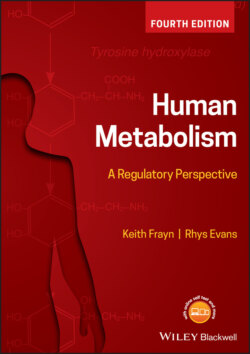Читать книгу Human Metabolism - Keith N. Frayn - Страница 12
CHAPTER 1 The underlying principles of human metabolism Key learning points
ОглавлениеWe eat food. We expend energy doing exercise, sleeping, just being. What happens to the food between it entering our mouths and its being used for energy? That’s what metabolism (at least, so far as this book is concerned) is all about.
In order to cover the periods when we are not eating, we need to store metabolic fuels. We store fuel as fat (triacylglycerol) and as carbohydrate (glycogen). Fat provides considerably more energy per gram stored. Proteins are not stored specifically as energy reserves but they may be utilised as such under certain conditions. We must regulate both the storage and mobilisation of energy to match intake to expenditure. That is what we will refer to as metabolic regulation.
Molecules involved in metabolism differ in an important property: polarity. Polar molecules (those with some degree of electrical charge) mix with water (which is also polar); non-polar molecules, which include most lipids (fatty substances), usually don’t mix with water. This has profound implications for the way they are handled in the body. They also differ in the amount of energy they contain, affecting their efficiency as fuels.
Some molecules have both polar and non-polar aspects: they are said to be amphipathic. They can form a bridge between polar and non-polar regions. Amphipathic phospholipid molecules can group together to form membranes, such as cell membranes.
Energy is derived from metabolic substrates derived from food-stuffs principally by oxidation, a chemical process involving electron transfer from electron donor (reducing agent) to electron acceptor (oxidising agent), the final electron acceptor being oxygen.
The different organs in the body have their own characteristic patterns of metabolism. Substrates flow between them in the bloodstream (circulation). Larger blood vessels divide into fine vessels (capillaries) within the tissues, so that the distances that molecules have to diffuse to or from the cells are relatively small (more detail in Chapter 3).
The different classes of metabolic substrates have characteristic chemical properties; by utilising all three types of metabolic substrates derived from the three major food energy groups (carbohydrates, fats, and proteins) energy storage (anabolism) and release (catabolism) in many physiological conditions is achieved.
General features of metabolism include synthesis and breakdown of substrates, and complete breakdown to release energy by oxidation. The tricarboxylic acid cycle (TCA cycle) is the central cellular mechanism for substrate oxidation to H2O and CO2, with consumption of O2. It operates within mitochondria.
Carbohydrate metabolism centres around the sugar glucose. Carbohydrate metabolic pathways include conversion to glycogen and its reverse, glucose breakdown and oxidation, glucose conversion to lipid, and synthesis of glucose (gluconeogenesis).
Lipid metabolism for energy centres on the interconversion of fatty acids and triacylglycerol. Triacylglycerol synthesis involves esterification of fatty acids with glycerol; triacylglycerol breakdown (lipolysis) involves liberation of fatty acids and glycerol from stored triacylglycerol. The oxidation of fatty acids occurs through a pathway known as β-oxidation.
Amino acid metabolism involves incorporation of amino acids into protein, and its reverse (protein synthesis and breakdown), and further metabolism of the amino acids, either to convert them to other substrates (e.g. lipids) or final oxidation. The nitrogen component of amino acids is disposed of by conversion to urea in the liver.
